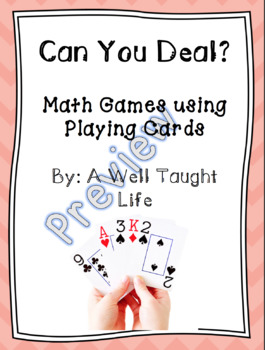Can You Deal? Math Games with Playing Cards
A Well Taught Life
8 Followers
Grade Levels
K - 5th
Subjects
Resource Type
Standards
CCSS1.NBT.A.1
CCSS1.NBT.B.2
CCSS1.NBT.B.2b
CCSS1.NBT.B.2c
CCSS1.NBT.B.3
Formats Included
- PDF
Pages
13 pages
A Well Taught Life
8 Followers
What educators are saying
We handed this out with playing cards at our Alice in Wonderland Trunk or Treat at school. It was a huge hit!
My students love using this resource during our math block. They love choosing their game of choice with their partner and are able to show success with the easy to follow directions.
Description
Math games/math station ideas using playing cards. Includes favorites such as war and go fish. Create for math review of addition, subtraction, multiplication, rounding, comparing numbers, and fractions.
Addition War
Subtraction War
Double Digit Addition War
Double Digit Subtraction War
Tens Go Fish
Comparison War
Double Digit Comparison War
Race to 27
Round the the Nearest Ten
Flipping Out
Multiplication War
Double Digit Multiplication War
Flip Three
Fraction Draw
Total Pages
13 pages
Answer Key
N/A
Teaching Duration
N/A
Report this resource to TPT
Reported resources will be reviewed by our team. Report this resource to let us know if this resource violates TPT’s content guidelines.
Standards
to see state-specific standards (only available in the US).
CCSS1.NBT.A.1
Count to 120, starting at any number less than 120. In this range, read and write numerals and represent a number of objects with a written numeral.
CCSS1.NBT.B.2
Understand that the two digits of a two-digit number represent amounts of tens and ones. Understand the following as special cases:
CCSS1.NBT.B.2b
The numbers from 11 to 19 are composed of a ten and one, two, three, four, five, six, seven, eight, or nine ones.
CCSS1.NBT.B.2c
The numbers 10, 20, 30, 40, 50, 60, 70, 80, 90 refer to one, two, three, four, five, six, seven, eight, or nine tens (and 0 ones).
CCSS1.NBT.B.3
Compare two two-digit numbers based on meanings of the tens and ones digits, recording the results of comparisons with the symbols >, =, and <.




